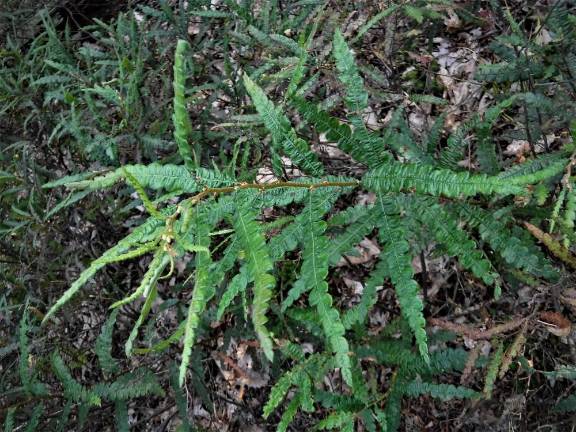The tastiest wild tea in all the land


Few drinks rival a cold glass of sweet tea on a hot summer’s day, but there is one: sweet fern tea. Sweet fern is the most tea-like native plant around, lining our region’s lush forest trails and bordering our sun-drenched meadows. It is also amongst the most delicious.
Sweet fern is not actually a fern at all, but a deciduous shrub with leaves that bear a strong resemblance to fern. Using its scientific name, Comptonia peregrina, would avoid this confusion, but it just doesn’t have the same ring to it. Sweet fern typically grows two to four feet tall, with widely spaced branches that are resinous — somewhat sticky — to the touch and softly hairy. Twigs bear forest green frond-shaped leaves with resinous, sometimes orangey, undersides that are strongly aromatic, especially when crushed. Volatile oils lend sweet fern this resinous quality as well as its unique spicy-sweet flavor, best likened in its complexity to a good chai.
To harvest, simply strip or pluck leaves from the twig. Traditionally, sweet fern is prepared as a cold water infusion, just a few leaves to a cup, allowing the leaves to infuse for several hours. This preparation really lets its sweetness shine, drawing out fewer tannins than a hot water infusion. A hot water infusion produces a beverage that is closer in flavor to a black tea and still quite pleasant. Medicinally speaking, sweet fern tea can be used as a digestive aid, quelling an upset stomach, and as an expectorant and decongestant, clearing the bronchial passages. Native Americans employed it as a blood purifier to enliven the body and reduce stagnancy — what we might call a detoxifier today. This same tea can even be used topically as a soak to reduce itchy bug bites or a poison ivy rash.
Look for sweet fern in copious sun. Unlike many of our other native plants, sweet fern can sometimes thrive amidst our human disturbance. It enjoys an open canopy and dry, sandy soil — a habitat we humans can be quite adept at creating through our clearing of land and development. Look for it along roadside embankments, and along power line and gas pipeline right of ways, as well as in more pristine habitats, such as lightly wooded ridges, sun-dappled trails and the edges of meadows.